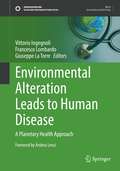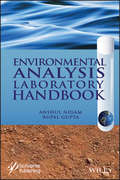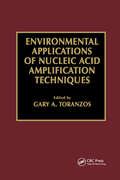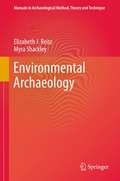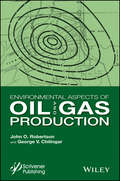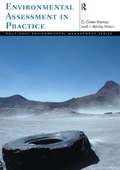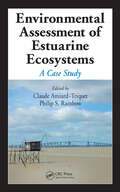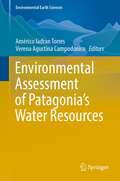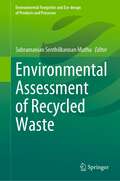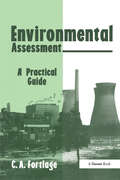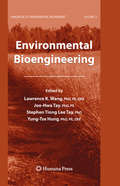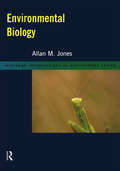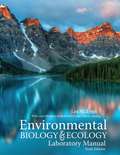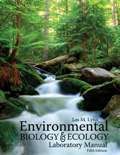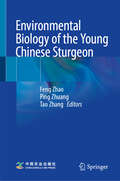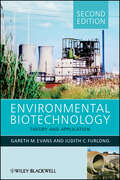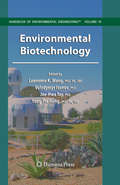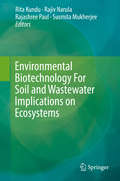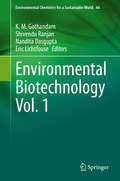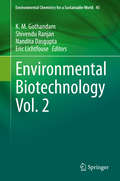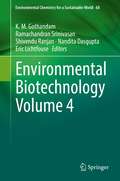- Table View
- List View
Environmental Alteration Leads to Human Disease: A Planetary Health Approach (Sustainable Development Goals Series)
by Giuseppe La Torre Vittorio Ingegnoli Francesco LombardoThis book aims to explore the impact of human alterations of Earth’s ecological systems on human health. Human activities are producing fundamental biophysical changes faster than ever before in the history of our species, which are accompanied by dangerous health effects. Drawing on advanced ecological principles, the book demonstrates the importance of using systemic medicine to study the effects of ecological alterations on human health. Planetary Health is an interdisciplinary field, but first of all it must be systemic and it needs a preferential relationship between Ecology and Medicine. This relation is to be upgrading, because today both ecology and medicine pursue few systemic characters and few correct interrelations. We need to refer to new principles and methods sustained by the most advanced fields, as Landscape Bionomics and Systemic Medicine. Thus, we will be able to better discover environmental syndromes and their consequences on human health. Environmental transformations proposed by PHA (from biodiversity shifts to climate change) do not consider bionomic dysfunctions which can menace human health. On the contrary, finding advanced diagnostic criteria in landscape syndromes can strongly help to find the effects on human well-being. The passage from sick care to health care can’t avoid the mentioned upgrading.
Environmental Analysis Laboratory Handbook
by Anshul Nigam Rupal GuptaToday, environmental issues are a great cause of concern at the global level, and universities and other institutions around the world are involved in research on climate change, deforestation, pollution control, and many other issues. Moreover, environmental science and environmental biotechnology are inherent parts of various courses while some universities provide degrees in these fields. Although the environment perspective of water is discussed time and again in research, academic, and non-academic discussions, there is no book summarizing protocols involved in water quality analysis. The information seems to be sporadically distributed on the internet. Even if available at all, the information does not discuss limits of the protocols or caveats involved. For example, essays on chemical oxygen demand (COD) on the internet mostly do not discuss differences between organic compounds of biological origin and aliphatic/aromatic. The authors have performed nearly all the protocols mentioned in this new volume, and their protocols are discussed in a simplified, easy-to-understand manner. The book has been written after elaborative discussions with and input from faculty and research students to ensure the clarity of the material for use on many levels. Further, the authors have emphasized low-cost methods which involve minimal use of high-end instrumentation keeping in mind limitations faced in developing countries. A valuable reference for engineers, scientists, chemists, and students, this volume is applicable to many different fields, across many different industries, at all levels. It is a must-have for any library.
Environmental Apocalypse in Science and Art: Designing Nightmares (Routledge Studies in Social and Political Thought #79)
by Sergio FavaAt a time when it is clear that climate change adaptation and mitigation are failing, this book examines how our assumptions about (valid and usable) knowledge are preventing effective climate action. Through a cross-disciplinary, empirically-based analysis of climate science and policy, the book situates the failures of climate policy in the cultural history of prediction and its interfaces with policy. Fava calls into question the current interfaces between scientific research and climate policy by tracing multiple connections between modelling, epistemology, politics, food security, religion, art, and the apocalyptic. Demonstrating how the current domination of climate policy by models and scenarios is part of the problem, the book examines how artistic practices are a critical location to ask questions differently, rethink environmental futures, and activate social change. The analysis starts with another moment of climatic change in recent western history: the overlap of the Little Ice Age and the "scientific revolution," during which intense climatic, scientific and political change were contemporary with mathematical calculation of the apocalypse. Dealing with the need for complex answers to complex and urgent questions, this is essential reading for those interested in climate action, interdisciplinary research and methodological innovation. The empirical analyses amount to a methodological experiment, across history of science, theology, art theory and history, architecture, future studies, climatology, computer modelling, and agricultural policy. This book is a major contribution to understanding how we are precluding effective climate action, and designing futures that resemble our worst nightmares.
Environmental Applications of Nucleic Acid Amplification Technology
by Gary A. ToranzosFrom the PrefaceAntibody techniques have allowed us to study microorganisms in situ. However, until recently all methodology lacked the sensitivity necessary for environmental work where microorganisms are in most cases present at very low concentrations or where microbial ecosystems contain a myriad of different organisms. Gene probes have been used successfully for a variety of samples, but this method was still not sensitive enough. The next logical step was the application of the recently developed DNA amplification technique known as the polymerase chain reaction, or PCR. Since then, many laboratories around the world have adopted PCR for environmental work. Samples obtained from soils, water and air are enormously complex because they are unknown mixtures of DNA and other compounds. Thus, procedures for target DNA amplification from the environment require special attention. The PCR has allowed us to go beyond the need for culturing prior to analysis of microbial communities. It has been shown that even microorganisms that can be routinely grown in the laboratory undergo some physiological changes when exposed to the environment. One of these changes (first observed by R. Colwell and colleagues) is known as the viable-but-non-culturable state, and seems to be a common occurrence. Thus, the use of culture techniques paint only part of the picture in terms of microbial behavior under environmental conditions. The ability to amplify nucleic acids by the PCR has brought about a myriad of very ingenious modifications to the technique that can then be used to study complex ecosystems. The manner in which the PCR can be modified is only limited by the need and/or the imagination of the researcher. The first manual dedicated specifically to the analysis (by PCR) of environmental samples, Environmental Applications of Nucleic Acid Amplification Techniques presents state of the art methodology for the detection of microorganisms in soil, water, air samples, as well as the amplification of nucleic acids from fossil samples. The manual gives step-by-step procedures for the analysis of these samples. Although several publications have addressed the use of Polymerase Chain Reaction technique, very few of them have been directed toward the application of this technique to environmental samples. This book fills this gap in the literature.
Environmental Archaeology
by Myra Shackley Elizabeth ReitzOne of the most significant developments in archaeology in recent years is the emergence of its environmental branch: the study of humans' interactions with their natural surroundings over long periods, and of organic remains instead of the artifacts and household items generally associated with sites. With the current attention paid to human responsibility for environmental change, this innovative field is recognized by scientists, conservation and heritage managers, and policymakers worldwide. In this context comes Environmental Archaeology by Elizabeth Reitz and Myra Shackley, updating the seminal 1981 text Environmental Archaeology by Myra Shackley. Rigorously detailed yet concise and accessible, this volume surveys the complex and technical field of environmental archaeology for researchers interested in the causes, consequences, and potential future impact of environmental change and archaeology. Its coverage acknowledges the multiple disciplines involved in the field, expanding the possibilities for using environmental data from archaeological sites in enriching related disciplines and improving communication among them. Introductory chapters explain the processes involved in the formation of sites, introduce research designs and field methods, and walk the reader through biological classifications before focusing on the various levels of biotic and abiotic materials found at sites, including:Sediments and soils.Viruses, bacteria, archaea, protists, and fungi.Bryophytes and vascular plants. Wood, charcoal, stems, leaves, and roots. Spores, pollen, and other microbotanical remains. Arthropods, molluscs, echinoderms, and vertebrates. Stable isotopes, elements, and biomolecules.The updated Environmental Archaeology is a major addition to the resource library of archaeologists, environmentalists, historians, researchers, policymakers--anyone involved in studying, managing, or preserving historical sites. The updated Environmental Archaeology is a major addition to the resource library of archaeologists, environmentalists, historians, researchers, policymakers--anyone involved in studying, managing, or preserving historical sites
Environmental Aspects of Oil and Gas Production
by George V. Chilingar John O. RobertsonOil and gas still power the bulk of our world, from automobiles and the power plants that supply electricity to our homes and businesses, to jet fuel, plastics, and many other products that enrich our lives. With the relatively recent development of hydraulic fracturing (“fracking”), multilateral, directional, and underbalanced drilling, and enhanced oil recovery, oil and gas production is more important and efficient than ever before. Along with these advancements, as with any new engineering process or technology, come challenges, many of them environmental. More than just a text that outlines the environmental challenges of oil and gas production that have always been there, such as gas migration and corrosion, this groundbreaking new volume takes on the most up-to-date processes and technologies involved in this field. Filled with dozens of case studies and examples, the authors, two of the most well-known and respected petroleum engineers in the world, have outlined all of the major environmental aspects of oil and gas production and how to navigate them, achieving a more efficient, effective, and profitable operation. This groundbreaking volume is a must-have for any petroleum engineer working in the field, and for students and faculty in petroleum engineering departments worldwide.
Environmental Assessment in Practice (Routledge Environmental Management)
by Owen Harrop Ashley NixonThis text explains what constitutes good practice in applying environmental assessment as an environmental management tool. A wide range of case studies and other student text features are employed to demonstrate how the different methods, techniques and disciplines of environmental assessment can be used. The authors address the key concepts for environmental assessment procedures: methods for using E.A.; techniques for impact prediction and evaluation; environmental risk assessment; EA consultation and participation; project management; environmental statement review and post-project analysis; and strategic environmental assessment.Worldwide case studies include: gas pipelines, hydroelectric power plants, gold mining, river crossings, waste-to-energy plants and gravel extraction in England, Scotland, Ireland, Canada, the USA, Venezuela, the Netherlands, Iceland, Zambia, Zimbabwe, South Africa and Ghana.
Environmental Assessment of Estuarine Ecosystems: A Case Study (Environmental and Ecological Risk Assessment)
by Philip S. Rainbow Claude Amiard TriquetEstuaries in every country exemplify the same paradox- they are among the most productive ecosystems and also among the most impacted by anthropogenic activities. And although estuarine biodiversity is key to the ecological and economic health of coastal regions, estuaries are exposed to toxic effluents transported by rivers from remote and nearby
Environmental Assessment of Patagonia's Water Resources (Environmental Earth Sciences)
by Américo Iadran Torres Verena Agustina CampodonicoThis book presents contributions devoted to the hydrogeochemical characterization of aquatic environments of Patagonia, including those of Ushuaia city, known as "The southernmost city in the world". Patagonia (between 39° and 55° S) is located in southern South America. Eight main river systems pour their waters into the SW Atlantic Ocean. Rivers, with their headwaters mainly located in the Andes, supply dissolved and particulate matter to the coastal zone, as well as nutrients, which benefit biological communities. Besides, freshwater in this region with little anthropogenic impact supports human life and a high wildlife biodiversity. Unfortunately, the recent increase in human activities, such as the use of fertilizers, wastewater discharges, extensive deforestation and dam construction, is affecting the quality and quantity of water resources. The book is of interest for researchers, professors and government agencies that decide on water resources management policies.
Environmental Assessment of Recycled Waste (Environmental Footprints and Eco-design of Products and Processes)
by Subramanian Senthilkannan MuthuThis book with its six interesting chapters highlights the environmental assessment of recycled waste. Waste Management is one of the main topics of concern for an organization and a nation. Out of different destinations at the end of life for a product, Recycling is the need of the hour and is an inevitable destination. Literally all wastes (be it- postindustrial or post-consumer states) if they cannot be reused, have to be recycled. Recycled products are in demand today and we are seeing many recycled alternatives for almost all industrial sectors. One of the million-dollar question to answer in terms of recycling and recycled products is- whether the recycled products are environmentally sustainable than the virgin alternatives? It is highly imperative to ascertain the environmental footprints of recycled products and recycling processes and also find out the best possible ways to further improve the environmental benefits of such recycled products and recycling processes.
Environmental Assessment: A Practical Guide
by C.A. FortlageEnvironmental assessment is a means of counteracting, foreseeing and controlling interference in the environment. All new major developments in Europe and North America are now subjects of scrutiny to prevent them from causing significant harmful effects to the land, sea or air. This book is an essential guide to the process, reviewing the history and background to assessment, summarizing the current legislation and providing useful advice on the skills and management techniques needed for a successful environmental assessment project. Environmental Assessment opens with a review of the US origins of the scheme, definitions and explanations of how the UK has implemented controls. This is followed by the law, rules, regulations and legislation applicable to the UK and the EC directives for the European Community. The author examines management and monitoring, setting up project teams, researching and presenting effective information, as well as calculating and analysing the potential effects of the project. Mitigating measures and alternatives are discussed, as are qualitative assessment techniques. The book has been written for architects, planners and landscape designers, who may be unfamiliar with the techniques, but who are directly involved in shaping the landscape. It would also be a valuable handbook for local planning authority councillors, environmental groups and anyone involved in sensitive development proposals. Although not written as a textbook, environmental students will discover clear jargon-free explanations of and insights into the practice of environmental assessment.
Environmental Bioengineering
by Lawrence K. Wang Yung-Tse Hung Stephen Tiong Tay Joo-Hwa TayThe impact of pollution on the environment has emerged as a particularly critical area of research in recent years. The Handbook of Environmental Engineering is a collection of methodologies that study the effects of pollution and waste in their three basic forms: gas, solid, and liquid. In this invaluable volume, Volume 11: Environmental Bioengineering, expert researchers explore the engineering applications of biotechnologies.A sister volume to Volume 10, Environmental Biotechnology, this work introduces such essential and varied topics as land disposal of biosolids, heavy metal removal by crops, pre-treatment and bio-treatment of sludge, fermentation of kitchen garbage, phyotoremediation for heavy metal contaminated soils, bioremediation, wetland treatment, biosorption of heavy metals, and rotating biological contactors (RBC) for carbon and nitrogen removal. A critical volume in the Handbook of Environmental Engineering series, chapters employ methods of practical design and calculation illustrated by numerical examples, include pertinent cost data whenever possible, and explore in great detail the fundamental principles of the field. Comprehensive and groundbreaking, Volume 11: Environmental Bioengineering presents innovative solutions to some of the most recent and significant pollution problems that the world is facing today.
Environmental Biology
by Mike CalverEnvironmental Biology offers a fresh, problem-solving treatment of the topic for students requiring a biology background before further study in environmental science, sustainable development or environmental engineering. It begins with an environmental theme that carries through the text, using three major case studies with a regional focus. Key foundational knowledge is introduced and developed as the text progresses, with students encouraged to integrate their accumulated learning to reach solutions. A comprehensive coverage of scientific method, including field experimentation and field techniques, is an important part of the approach. While emphasising the environmental theme, the book introduces all facets of the biology discipline, including cell biology, evolution, ecology, conservation and restoration. There are over 500 line drawings, diagrams and photos throughout, including full-colour sections, and each chapter includes summaries and comprehensive questions. The accompanying online Instructors' Resource includes multiple-choice questions, 'Test your knowledge' solutions and video footage.
Environmental Biology (Routledge Introductions to Environment: Environmental Science)
by Allan M. JonesEnvironmental Biology offers an accessible introduction to the core elements of biology and the biosphere. With balanced coverage of acquatic and terrestrial examples throughout, the text builds logically to present a clear understanding of the fundamental processes of life before examining its more complex components, namely individuals, populations, communities and ecosystems.A knowledge of environmental biology and its practical applications is essential for a deeper understanding of the environment. Environmental Biology offers an invaluable introduction to the living environment for all areas of study, from environmental history, agriculture and forestry, to impact assessment, climate change, ecology and conservation.
Environmental Biology and Ecology Laboratory Manual
by Les M LynnIn a society concerned with climate change, overpopulation, and extinction, ecology provides a scientific link to the living world. At the individual level, ecology investigates the impact of environmental factors on organisms through their physiology and behaviour. This Sixth Edition of Environmental Biology & Ecology Laboratory Manual by Les M. Lynn contains fifteen exercises which includes Use of the Microscope and also Environmental Inventory. This will be a very useful manual and research guide for students of Environmental Biology and Ecology.
Environmental Biology and Ecology Laboratory Manual (Fifth Edition)
by Les M. LynnThis manual has engaging lab exercises for students learning environmental biology and ecology and also intends to spark a curiosity into the environment around them.
Environmental Biology of the Young Chinese Sturgeon
by Tao Zhang Feng Zhao Ping ZhuangThis book provides a comprehensive coverage of the advances in biology and conservation research on Chinese sturgeon in the Yangtze Estuary. The chapters feature the latest developments in Chinese sturgeon research and cover topics such as early development and ontogenetic behaviour, growth and feeding, ecophysiology, ecotoxicology, population dynamics, conservation management, etc. The volume not only lays a foundation for the research and conservation of Chinese sturgeon but also provides references for other sturgeons. It is an invaluable reference for sturgeon researchers. The translation was done with the help of artificial intelligence. A subsequent human revision was done primarily in terms of content.
Environmental Biology: Laboratory Activities
by Ron Dinchak Larry BrickerLab book for Bio 105 Environmental Biology
Environmental Biotechnology
by Judy Furlong Gareth G. EvansEnvironmental Biotechnology: Theory and Applications, 2nd Edition is designed to draw together the microscopic, functional level and the macroscopic, practical applications of biotechnology and to explain how the two relate within an environmental context. It presents the practical biological approaches currently employed to address environmental problems and provides the reader with a working knowledge of the science that underpins them. Biotechnology has now become a realistic alternative to many established approaches for manufacturing, land remediation, pollution control and waste management and is therefore an essential aspect of environmental studies. Fully updated to reflect new developments in the field and with numerous new case studies throughout this edition will be essential reading for undergraduates and masters students taking modules in Biotechnology or Pollution Control as part of Environmental Science, Environmental Management or Environmental Biology programmes.Quote from the first edition:"There is no doubt that this book will be one of inspiration for all professionals in the field. It is a very good framework for understanding the complex nature of processes and technology and as such it will be useful for researchers, practitioners and other parties who need a working knowledge of this fascinating subject."--Professor Bjorn Jensen, Chairman of the European Federation of Biotechnology, Environmental Biotechnology section and Research and Innovation Director, DHI Water and Environment
Environmental Biotechnology
by Lawrence K. Wang Yung-Tse Hung Joo-Hwa Tay Volodymyr IvanovVolume 10: Environmental Biotechnology in the Handbook of Environmental Engineering series presents the theories and principles of various environmental biotechnologies. This outstanding collection of science information is designed as a basic Environmental Biotechnology textbook as well as a reference book for scientists, researchers, educators, and engineers. The book's expert panel of authors provides an introduction at a wide range of topics, including sanitary microbiology, microbial systematics, ecology, microbial metabolism, life support systems, solid-state processes and reactors, value-added biotechnology products, anaerobic processes, membrane bioreactors, space life support systems, biospherics, natural environmental systems, aerobic and anoxic biotechnologies, sequencing batch reactors, and flotation biological systems. Volume 10: Environmental Biotechnology and its sister book - Volume 11: Environmental Bioengineering - are indispensable as both basic biotechnology textbooks and comprehensive reference books for all environmentalists. Another gold-standard addition to The Humana Press series, Volume 10: Environmental Biotechnology gives readers a cutting-edge illustration of the theories and principles of biotechnologies, systems, processes, and methodologies. Coverage of basic and advanced environmental biotechnologies, systems, methodologies, and processes. Emphasis on detailed descriptions, introductions, theories, principles, classifications, and mechanisms of microbiology, ecology, life support systems, and biological processes. Reference of practical use to scientists, researchers, educators and engineers. Contents Environmental biotechnology, microbiology, microbial systematics, ecology, metabolism, life support systems, solid-state processes and reactors, value-added biotechnology products, anaerobic suspended biological processes, membrane bioreactors, closed ecological systems, space life support systems, biospherics, natural environmental biotechnologies, aerobic processes, anoxic processes, suspended-growth processed, attached-growth processes, and flotation biological systems.
Environmental Biotechnology For Soil and Wastewater Implications on Ecosystems
by Rita Kundu Rajiv Narula Rajashree Paul Susmita MukherjeeThis book comprises some of the major facts and solutions on environmental studies and its importance on the ecosystem. Implementations of Biotechnology on wastewater treatment and removal of toxins from the wastewater have been thoroughly discussed in different chapters with its impacts on the ecosystem. State of art technologies related to the water treatment as well as balancing of various essential components of the ecosystem has also been demonstrated with various technical solutions. Impacts of various toxins, mainly chemical wastes produced by various industries have been precisely identified and there impacts with various solutions are also discussed. This book is also a collection of various ideas and thoughts coming from reputed scientists and researchers working in this field with modernized technological views. A special emphasis has been given to protect and balance our ecosystem to save the entire living beings. Authors have also tried to make a bridge between bioremediation and ecosystem to bring these in a common platform for better understanding and solution of various critical problems with the help of cutting edge technologies. In this particular aspect or research, the novelty of the book is unparallel to show various future opportunities for the researchers, academicians, industrial personnel working in this field.
Environmental Biotechnology Vol. 1 (Environmental Chemistry for a Sustainable World #44)
by Eric Lichtfouse Shivendu Ranjan Nandita Dasgupta K. M. GothandamThis book provides the information on the application of nanotechnology in cleaning wastewater and the impact of microbial ecosystem to solve environmental problems has been critically reviewed in the chapters. It also gives detailed reviews about the conversion of wastewater nutrients into a biofertilizer using microalgae, as well as the applications of Biochar for heavy metal remediation from water. Most importantly, this book contains critical review on microbial fuel cells and highlights the emerging risks of bioplastics on the aquatic ecosystem.
Environmental Biotechnology Vol. 2 (Environmental Chemistry for a Sustainable World #45)
by Eric Lichtfouse Shivendu Ranjan Nandita Dasgupta K. M. GothandamThis book provides the technological insight on biorefinery and nanoremediation and provides comprehensive reviews on applications of Biochar for environmental sustainability. Critical review on biosurfectants in food applications as well as sustainable agricultural practices has also been provided in this book. It also highlights the microbial-omics and microRNAs for protecting ecotoxicity. Overall, this book provides critical as well as comprehensive chapters on wastewater treatment using different technologies.
Environmental Biotechnology Vol. 3 (Environmental Chemistry for a Sustainable World #50)
by Eric Lichtfouse Shivendu Ranjan Nandita Dasgupta K. M. GothandamThis volume is a collection of informative chapters on various subjects. It provides information on the effects of pesticides on avian fauna, the impact of microbial ecosystems to solve environmental problems, a detailed review on issues in membrane distillations process, microbial sensor for detection of pollutants, microbial biosurfactants, biotechnological applications of immobilised microalgae as well as a review on Biochar production. Most importantly, this book contains a critical review on microbial degradation of plastic wastes and highlights the Biodegradation and Bioremediation of Herbicides.
Environmental Biotechnology Volume 4 (Environmental Chemistry for a Sustainable World #68)
by Eric Lichtfouse Shivendu Ranjan Nandita Dasgupta K. M. Gothandam Ramachandran SrinivasanThis book reviews the production of bioplastic from various raw materials and recycling wastewater into useful bioproducts by bacteria. In addition, it also addresses the recent advancement in pest control in rice plants, different methods to analyse genotoxicity on soil samples and the effect of phytocompounds on acrylamide-induced toxicity in Drosophilla. Interestingly, this book also discusses mesoporous silica nanoparticles' role as nanocarrier material for inhibiting the cancer cell, especially breast cancer and various biotechnological applications of marine fungal exopolysaccharides.
